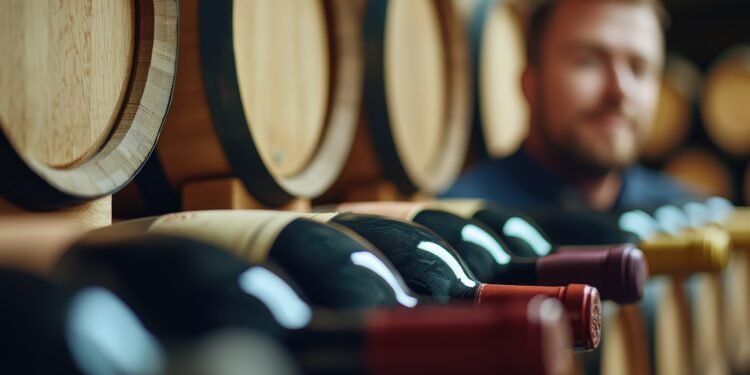Wine Collecting as Investment: From Passion to Portfolio Strategy
The world of fine wine collecting occupies a unique space in the investment landscape, sitting at the intersection of personal passion and financial strategy. For many wine enthusiasts, the journey into accumulating rare vintages doesn’t begin with spreadsheets, return calculations, or portfolio diversification strategies. Instead, it typically starts much more organically—as a genuine love for wine, an appreciation for specific regions or producers, and the simple joy of discovering exceptional bottles. However, what often begins as a hobby or passion project can gradually transform into a collection that holds substantial monetary value, sometimes surprising even the collectors themselves.
Brennan Decima, who owns Decima Wealth Consulting in St. Petersburg, Florida, has witnessed this evolution firsthand among his clientele. He notes that he has several clients who take considerable pride in the wine collections they’ve built over the years. These collections represent not just financial assets but also personal histories—bottles acquired during memorable trips, special occasions, or moments of discovery. “Investing in wine tends to be a more exciting conversation starter than telling people you hold an index fund,” Decima observed, highlighting how wine investments carry a cultural and experiential dimension that traditional financial instruments simply cannot match.
Wine as an Alternative Investment Class
Annie Edgerton, a highly credentialed wine expert who works with Flatiron Wines & Spirits in New York City, emphasizes that wine collections “offer more than luxury sips.” According to Edgerton, fine wine “presents an increasingly sophisticated alternative investment class” that deserves serious consideration alongside more conventional investment vehicles.
Edgerton brings impressive credentials to her analysis of wine as an investment. She recently assumed leadership of her family’s business, Edgerton Wine Appraisals, continuing a legacy of professional wine evaluation. Her expertise is further demonstrated by her status as a master of wine candidate at the prestigious Institute of Masters of Wine, one of the wine world’s highest achievements. She also holds a Wine & Spirit Education Trust diploma in wines and spirits and has earned certification as a sommelier from the Court of Master Sommeliers—credentials that collectively represent years of study and practical experience in every aspect of wine.
The investment case for fine wine rests on fundamental economic principles of supply and demand. While global demand for collectible wines certainly fluctuates, influenced by broader market trends, economic conditions in key consumer markets, and shifting tastes among collectors, the supply side presents inherent constraints. Unlike stocks, where companies can issue more shares, or bonds, where governments and corporations can create new debt, wine production is naturally limited by vintage variations—the unpredictable effects of weather, climate, and growing conditions each year—and by production constraints at individual wineries.
“Therefore, investing in the right wines can yield significant long-term returns,” Edgerton explained. The key phrase here is “the right wines”—not all wine appreciates in value, and selecting bottles with genuine investment potential requires knowledge, research, and often professional guidance.
Due Diligence and Proper Storage: Essential Requirements
However, clients who wish to maintain and grow the value of their wine collections must understand that ownership comes with responsibilities. Two critical factors determine whether a wine collection maintains or increases its value over time: performing thorough due diligence when acquiring bottles and maintaining proper storage conditions to ensure the longevity of the investment.
Unlike stocks that exist as electronic entries or real estate that requires minimal day-to-day attention, wine is a living, evolving product that can be damaged or destroyed by improper conditions. A bottle purchased for thousands of dollars can become worthless if stored incorrectly, making proper care absolutely essential for anyone viewing wine as an investment rather than merely something to drink.
Identifying Investment-Worthy Wines
For collectors looking to build a wine portfolio with genuine investment potential, focusing on bottles from high-end producers with established track records of excellence offers the most dependable path to growth. These aren’t experimental wineries or unproven regions—they’re estates that have demonstrated consistent quality over decades, sometimes centuries.
Edgerton identified several examples of such prestigious producers. From Burgundy, France, comes Domaine de la Romanée-Conti, often considered the pinnacle of Burgundian winemaking and one of the most sought-after wine producers in the world. From Tuscany, Italy, Masseto represents the heights of Italian winemaking, producing wines that command extraordinary prices. And from Napa Valley in California, Screaming Eagle has achieved cult status among collectors, with bottles regularly selling for thousands of dollars.
These top-tier producers offer what Edgerton describes as a low-risk opportunity within the wine investment space. “Yes, one needs to monitor trade structures and auctions to be alerted to potential market trends and softening, but classic producers at the top of their game are likely to stay there,” she explained. The reputation and consistent quality of these estates provides a degree of stability that lesser-known producers cannot match.
However, this relative safety comes with trade-offs. These wines are already expensive when purchased, which means the potential for dramatic percentage gains may be limited compared to discovering an undervalued producer before they achieve wider recognition. “And production is so low, they may be difficult to acquire in the first place,” Edgerton noted. Many of these wines are allocated in small quantities to established clients or sold through exclusive channels, making access itself a challenge.
The Fundamentals of Collectability
What ultimately determines whether a wine becomes collectible and appreciates in value? Edgerton identifies three key factors: limited availability, high quality, and the ability to improve or remain stable over extended aging periods.
“Simply, if many people want to drink or own something that is well-regarded, difficult to obtain and has the potential to provide enjoyment for an extended period, they’ll pay for the opportunity,” she explained. This creates a classic supply-demand imbalance where passionate collectors compete for scarce resources, driving prices upward.
Importantly, Edgerton notes that “most of our clients appreciate the dual nature of collecting wine; the potential to improve their investment, and the pleasure of sharing some special bottles with friends and family along the way.” This dual-purpose aspect distinguishes wine from purely financial investments—collectors can enjoy some bottles while others appreciate in value, creating both experiential and financial returns.
The Critical Importance of Proper Storage
Wine storage represents one of the most crucial yet commonly misunderstood aspects of wine collecting. Much like other temperamental collectibles such as classic cars and vintage guitars, wine requires specific environmental conditions to maintain its quality and value.
Room temperature—the normal temperature of most homes—will prematurely age wine, accelerating chemical reactions that degrade the wine’s character and structure. One of the primary requirements is maintaining wine at a constant temperature, which most experts recommend should be approximately 55 degrees Fahrenheit. Consistency matters as much as the actual temperature—fluctuations cause the wine to expand and contract, potentially compromising the seal and allowing oxygen infiltration that damages the wine.
As a professional wine appraiser, Edgerton has seen storage mistakes play out repeatedly, often with expensive consequences. One of the most frequent tasks she performs is tasting wine to assess damage from improper storage. The financial implications can be devastating—thousands of dollars in wine value can be destroyed by storage failures.
Collectors should be particularly wary of relying on natural basements that seem “always cool.” While these spaces may feel appropriately cool when visited, they remain subject to temperature fluctuations with changing seasons and weather conditions. These variations can accelerate a wine’s development, pushing it past its optimal drinking window and significantly reducing its value.
“A seemingly minor heat event like a power outage affecting cooling to the wine cellar for a few days can result in a total loss of value,” Edgerton warned. This stark reality underscores why serious collectors invest in professional storage solutions with backup power systems and monitoring technology.
Market Performance: Real-World Examples
When collectors eventually decide to liquidate their wine investments, reputable auction houses offer the most reliable channels for achieving optimal returns. These established auction houses scrutinize provenance (the documented history of a bottle’s storage and ownership), condition, and authenticity to help protect buyers and sellers from problematic wines, including counterfeits.
“There are also some merchants, online and brick-and-mortar, who specialize in collectible wines, but due diligence should be carried out to ensure you are buying from a fair and respected seller,” Edgerton advised.
Sale prices for rare wines demonstrate substantial variation based on numerous factors and can fluctuate significantly over time. Real-world examples illustrate both the potential and the limitations of wine as an investment.
Consider the 2005 Domaine de la Romanée-Conti, a red Burgundy from one of the world’s most prestigious producers. When this vintage first appeared on the secondary market in 2009, bottles sold at auction in the United States for approximately $10,000 to $11,000 each. More recent U.S. sales have occurred in the $17,000 to $22,000 range, representing substantial appreciation over roughly a decade and a half.
However, not all wines follow this upward trajectory. Vintage ports, while often prized by collectors for their remarkable longevity and ability to age for decades, don’t typically see dramatic price growth. Both the 1994 Taylor and 1994 Fonseca—two highly regarded vintage ports—entered the market in the late 1990s at around $110 to $120 per bottle. Today, these same bottles trade at essentially the same price range, showing no real appreciation despite more than two decades of aging.
The broader context for wine investment includes some challenging headwinds. The entire alcohol market has experienced a downward trend, with wine sales worldwide recently reaching a six-decade low. This reflects changing consumer preferences, generational shifts in drinking habits, and competition from other beverage categories.
Many industry observers have noted particular softening in the prestige and prices of Bordeaux wines, which have trended downward in recent years. However, even within this challenged category, specific bottles have performed well. The 2000 Château Mouton Rothschild sold at early auctions in the $350 to $420 range. Recently, the same bottles have traded around $1,500 to $1,700. “A savvy investor would likely be quite pleased with that return, in spite of the trade’s somewhat gloomy outlook,” Edgerton observed.
The ‘Drinking for Free’ Strategy
These impressive returns come with important caveats. Success in wine investment requires the ability to purchase top wines early—often upon release or shortly thereafter—and extraordinary patience measured in years or even decades as the wines mature and appreciate.
However, Edgerton describes an approach that many collectors find appealing: “But if an investor can acquire two cases of a well-regarded wine upon release, and drink a bottle from one every year or two for the next 15 years, enjoying the evolution of a quality wine over its lifetime, then sell the other case for two times or more what he or she paid, I don’t think even the wealthiest collector minds ‘drinking for free.'”
This strategy combines the experiential pleasure of watching a wine evolve with the financial return of selling appreciated bottles. “At the end of the day, wine is a special commodity, with the ability to provide profit and pleasure, as long as it’s well taken care of,” she concluded.
Wine’s Place in Overall Financial Planning
Despite the potential for returns and the pride collectors take in their cellars, financial advisor Decima emphasizes an important perspective. Even among his clients who greatly prize their wine collections, it’s rare for someone to view wine as a primary component of their financial plan.
“Wine isn’t something that my clients are banking on to pay for their retirement or cover their monthly bills,” he said. This perspective is crucial—wine should be viewed as an alternative asset that adds diversification and enjoyment rather than as a core holding that one depends on for financial security. The combination of storage requirements, market unpredictability, and liquidity challenges means wine works best as a supplementary investment for those who genuinely appreciate it, not as a substitute for traditional retirement planning.
Acknowledgment: This article was written with the help of AI, which also assisted in research, drafting, editing, and formatting this current version.







